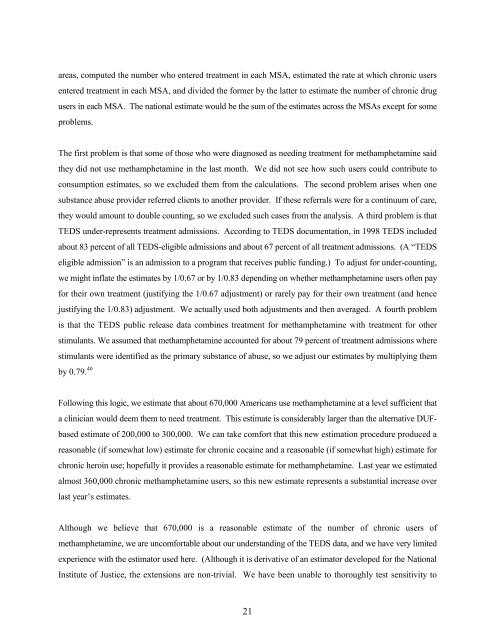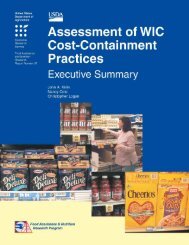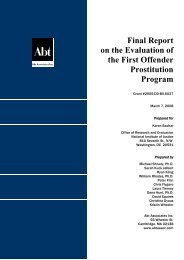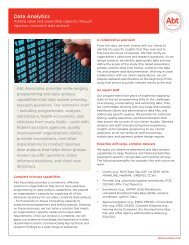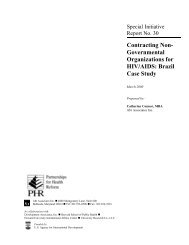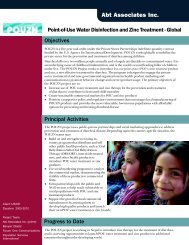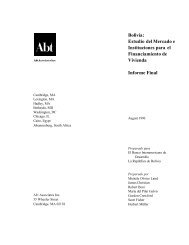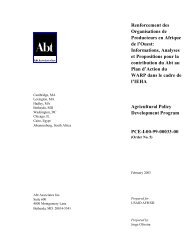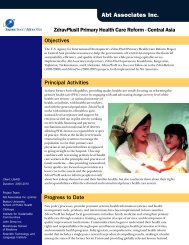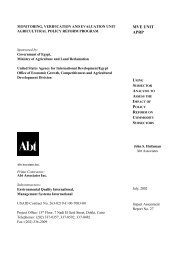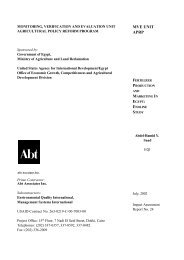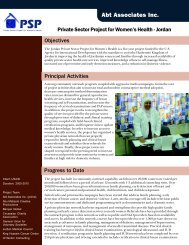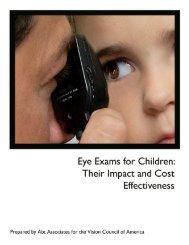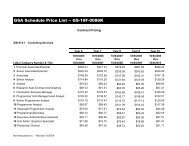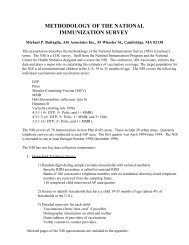What America's Users Spend on Illegal Drugs 1988-2000 - National ...
What America's Users Spend on Illegal Drugs 1988-2000 - National ...
What America's Users Spend on Illegal Drugs 1988-2000 - National ...
- No tags were found...
Create successful ePaper yourself
Turn your PDF publications into a flip-book with our unique Google optimized e-Paper software.
areas, computed the number who entered treatment in each MSA, estimated the rate at which chr<strong>on</strong>ic usersentered treatment in each MSA, and divided the former by the latter to estimate the number of chr<strong>on</strong>ic drugusers in each MSA. The nati<strong>on</strong>al estimate would be the sum of the estimates across the MSAs except for someproblems.The first problem is that some of those who were diagnosed as needing treatment for methamphetamine saidthey did not use methamphetamine in the last m<strong>on</strong>th. We did not see how such users could c<strong>on</strong>tribute toc<strong>on</strong>sumpti<strong>on</strong> estimates, so we excluded them from the calculati<strong>on</strong>s. The sec<strong>on</strong>d problem arises when <strong>on</strong>esubstance abuse provider referred clients to another provider. If these referrals were for a c<strong>on</strong>tinuum of care,they would amount to double counting, so we excluded such cases from the analysis. A third problem is thatTEDS under-represents treatment admissi<strong>on</strong>s. According to TEDS documentati<strong>on</strong>, in 1998 TEDS includedabout 83 percent of all TEDS-eligible admissi<strong>on</strong>s and about 67 percent of all treatment admissi<strong>on</strong>s. (A “TEDSeligible admissi<strong>on</strong>” is an admissi<strong>on</strong> to a program that receives public funding.) To adjust for under-counting,we might inflate the estimates by 1/0.67 or by 1/0.83 depending <strong>on</strong> whether methamphetamine users often payfor their own treatment (justifying the 1/0.67 adjustment) or rarely pay for their own treatment (and hencejustifying the 1/0.83) adjustment. We actually used both adjustments and then averaged. A fourth problemis that the TEDS public release data combines treatment for methamphetamine with treatment for otherstimulants. We assumed that methamphetamine accounted for about 79 percent of treatment admissi<strong>on</strong>s wherestimulants were identified as the primary substance of abuse, so we adjust our estimates by multiplying themby 0.79. 40Following this logic, we estimate that about 670,000 Americans use methamphetamine at a level sufficient thata clinician would deem them to need treatment. This estimate is c<strong>on</strong>siderably larger than the alternative DUFbasedestimate of 200,000 to 300,000. We can take comfort that this new estimati<strong>on</strong> procedure produced areas<strong>on</strong>able (if somewhat low) estimate for chr<strong>on</strong>ic cocaine and a reas<strong>on</strong>able (if somewhat high) estimate forchr<strong>on</strong>ic heroin use; hopefully it provides a reas<strong>on</strong>able estimate for methamphetamine. Last year we estimatedalmost 360,000 chr<strong>on</strong>ic methamphetamine users, so this new estimate represents a substantial increase overlast year’s estimates.Although we believe that 670,000 is a reas<strong>on</strong>able estimate of the number of chr<strong>on</strong>ic users ofmethamphetamine, we are uncomfortable about our understanding of the TEDS data, and we have very limitedexperience with the estimator used here. (Although it is derivative of an estimator developed for the Nati<strong>on</strong>alInstitute of Justice, the extensi<strong>on</strong>s are n<strong>on</strong>-trivial. We have been unable to thoroughly test sensitivity to21


